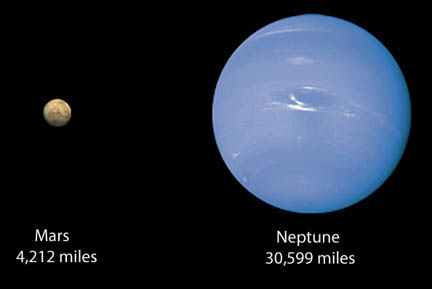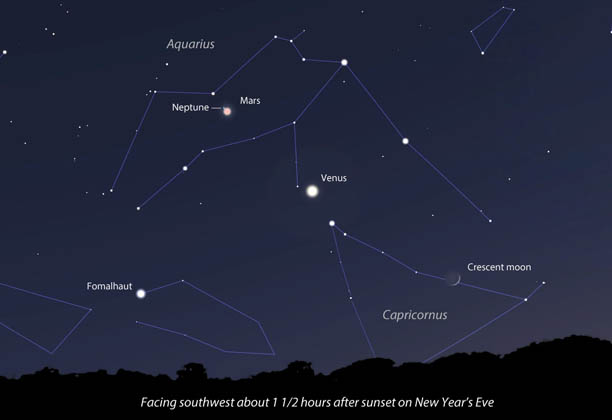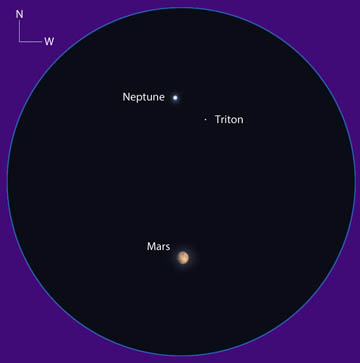Doing anything on New Year's Eve? Before you start toasting, don't miss an exceptionally close conjunction of Mars and Neptune.

Source: Lunar and Planetary Institute
What an unlikely pair. A small, sunburned desert planet half the size of Earth scrunched up against a big blue ice giant with an oceanic atmosphere. On New Year's Eve, Mars and Neptune will wheel across the twilight sky as close together as two strangers in a New York subway car.
That evening, as seen from the East Coast, only 14 arcminutes (14′ or just 0.2°) will separate the two planets. Mars, being much closer to Earth, has a greater apparent motion across the sky; a careful observer can actually see it move slightly eastward each night against the background stars with only the naked eye. As it glides eastward on December 31st, the Red Planet approaches Neptune more closely with each passing hour. When dusk finally reddens the sky in the Pacific Northwest, the chummy couple will be only 9′ apart.

Map: Bob King; source: Stellarium
It gets better. The distance between them shrinks to just 1 arcminute or 0.016° around 12:45 a.m. Central Standard Time on January 1st. Man, that's close! Pity the planets will have already set or be near setting for the continental U.S. and Canada. But not for Hawaii. Mars and Neptune will still be up in the western sky around 8:45 p.m. Hawaiian-Aleutian Standard Time. I really need to get to Hawaii more often — and not just because they have great conjunctions there.

Maps: Bob King; source: Stellarium
The amazing thing with all close conjunctions such as this one is how apparently close two planets can get when in reality they're incredibly far apart. They only appear like they're almost touching because we see them along the same line of sight. Truth to tell, the two are a cool 2,675,000,000 miles apart. Mars seems only a stone's throw from Earth at 150 million miles compared to Neptune's 2.8 billion miles, but line 'em up and it's party time.
So what exactly will we see? Neptune is invisible without optical aid, but lucky for us, very little such aid is needed. The remote planet pops into view with a pair of 50-mm (or larger) binoculars and in virtually any telescope. Point your glass at Mars, and look for a little point of light a very short distance above and to its left (east). Neptune will be the only close "star" to Mars. Farther west, in Hawaii, Neptune will glimmer above and a tad to the right of the Red Planet.

Map: Bob King; source: Stellarium
Binoculars will easily split the duo except possibly during their closest approach. Then, depending on the binocular's magnification, the otherwise untouchable worlds might appear to touch.
I encourage you to observe Mars and Neptune together at high magnification in a telescope. Mars will appear gibbous and 5.8″ across compared to Neptune's 2.3″. The color contrast between the two should be striking: red ocher and blue chill.
If you're using an 8-inch or larger instrument be sure to look for Neptune's largest moon, Triton, which will appear as a faint spark of 14th-magnitude light immediately south-southwest of the planet.
While Mars and Neptune are closest on New Year's Eve, they'll still neighbors on the 30th, when the blue planet lies about 1° to the upper left of Mars and again on January 1st, when it's 0.5° to the lower right of Mars. If you've never seen the eighth and (so far) final planet in our solar system, it couldn't be easier. All you need now are clear skies. Yeah, I know, that's the hard part.
And before I forget — Happy New Year! May 2017 provide clear nights and fantastic sights for all.
 18
18








Comments
Anthony Barreiro
December 29, 2016 at 6:31 pm
Thanks Bob. Our astronomy club's monthly star party is scheduled for new years eve. The weather forecast keeps changing, but we have a chance for clear skies. Such a close planetary conjunction would be a real treat!
You must be logged in to post a comment.
Bob KingPost Author
December 29, 2016 at 10:58 pm
I'm looking forward to it, too. Hope you clear out, Anthony. Best wishes for 2017!
You must be logged in to post a comment.
Anthony Barreiro
January 2, 2017 at 9:34 pm
I saw them. 70 mm f/6 refractor, maximum magnification 96x. I was surprised how easy it was to recognize Neptune.
You must be logged in to post a comment.
Bob KingPost Author
January 3, 2017 at 10:03 am
Anthony,
I am jealous 😉 We were overcast with light snow; no photons from any outer planets could penetrate the clouds.
You must be logged in to post a comment.
Anthony Barreiro
January 4, 2017 at 3:11 pm
Oh, I'm sorry. It was quite a sight. I've seen Neptune before, but this was the only time I was immediately certain which 8th magnitude mote was Neptune.
You must be logged in to post a comment.
December 30, 2016 at 4:57 pm
When you talk about Neptune being to the 'left' or 'right' of Mars I think that depends on whether you are using a star diagonal or not. For an SCT/refractor anyway.
You must be logged in to post a comment.
Bob KingPost Author
December 31, 2016 at 2:13 pm
Hi goodricke,
The "left" reference refers to the binocular view, the one most described in the article, so left refers to east. I also noted the direction in the three-scene panel. Sorry if this was unclear.
You must be logged in to post a comment.
Aqua4U
January 2, 2017 at 11:03 pm
I put this event on my calendar then went outside with my new 15X70 Celestron Sky Master binocs to look at a dense marine layer... rats. At least now I know whereabouts to look for Neptune!
You must be logged in to post a comment.
Bob KingPost Author
January 3, 2017 at 10:14 am
I know how it goes, Aqua. We had clouds here, too. Pity, I really wanted to see this one.
You must be logged in to post a comment.
SNH
January 3, 2017 at 4:02 pm
I was surprised when I read your article that I hadn't already known about this conjunction. I figured though that it didn't matter much because they were calling for clouds on the 31st. Well, surprise!, it was clear. I got out there then and looked at it using my 8x56 binoculars. Even showed a few of my siblings. Fog was rolling in and less than an hour later it was completely overcast with fog or clouds. Good article!
You must be logged in to post a comment.
Bob KingPost Author
January 3, 2017 at 8:38 pm
Thanks SNH! Nice to know you were able to see the close conjunction. Mars will do it again - though not so closely - with Uranus (0.5°) on Feb. 26.
You must be logged in to post a comment.
Graham-Wolf
January 10, 2017 at 6:28 pm
Thank you, Bob, for the timely warning about the Mars-Neptune conjunction, on New Years Eve.
Just before rushing off to the Dunedin New Year's Eve Fireworks display at ~ 11:30pm, had a quick look outside at Mars with the 12cm f 7.5 Equatorial Newtonian at 60x (using a GSO SV15 Superview ocular... 70 arcmin FOV). There was Mars, and nearby a blue bloated star-like object... Neptune!
In recent days, in deep twilight last week, I've used Mars and Venus to line up on 45p/ H-M-P.
A rather nice "not-so-close conjunction" of it's own.
Atop the summit trig of Scroggs Hill, overlooking the Taieri Basin some 50km+ to the West, I acquired the comet ~ 11:30pm NZDT!
Data is:-
2017 Jan 07.439 UT Mv 5.9 (Sidgewick) 6 arcmin coma DC7/8 10x50B (5df)
Site (Scroggs Hill Summit):- 45.917015 South, +170.312337 East.
Used my own AAVSO-VSP Charts (20df MLim 10 around Theta Capricornus).
Some lunar pollution to the North.
Traced a straight line from Mars to Venus to Theta Capricornus, then offset to the comet..
ZLM +5.0. LM FOV ~ 6.5, no tail structure seen to mid 6th Mv.
Strong SW frontal clouds and 80kph+ winds.
A 20 deg x 5 degree cloud- hole opened up for 2 minutes on the Western horizon, then closed over very quickly again.
Solar Elongation was 26 to 28 degrees.
Very nice!
Regards from 46 South, NZ. Graham W. Wolf.
You must be logged in to post a comment.
Bob KingPost Author
January 10, 2017 at 8:23 pm
Graham-Wolf,
Thank you! That's exciting news about 45P. Still brightening nicely. I'm eager to get out for a look after full moon. By the way, have you seen C/2016 U1 NEOWISE at dawn. It's really brightened up - about 7 now and very condensed with DC=7/8, similar to 45P.
You must be logged in to post a comment.
Graham-Wolf
January 11, 2017 at 5:22 pm
Sure did Bob!
About a week or so ago, between Westerly frontal cloud systems, when the skies to the East over Green Island and Abbotsford, would suddenly clear for an hour or two, from 3am local time...
Nice views in the 20x80 Polarex (1976 period f5 Spotterscope refractor). 2 deg FOV.
At present, local 46 South dawn-onset (~4am NZDT).
Comet C/2016 U1 NEOWISE currently found in OIphiuchus:- not far from Saturn, with mighty Jupiter and Anatres close by in attendance (just as in your Charts, and those of Gary Kronk). It has indeed brightened, as you have said, but this week, a Full Moon is rather spoiling things... could someone please adjust the rheostat on that big bright lump of rock out there! As you have said, Bob, 2016 U1 sure did have some visual appearance to 45p.
I'm sure our Anthony is out there, going "hard" thorugh your recent comet-hunting list!
That makes at least 3 of us...
Also keenly hoping:- like yourself, to visually acquire 45p once the Full Moon is out of the way... (say, February), once it's safely post Solar Conjunction.
Keep up the great work out there, Bob!
Regards from 46 South, NZ. Graham W. Wolf.
REgards from 46 South, NZ. Graham W. Wolf.
You must be logged in to post a comment.
Graham-Wolf
January 15, 2017 at 5:06 pm
My profuse apologies, Bob.
Have NOT seen NEOWISE.... had a recent sickie last 3 weeks or so:- Rotavirus, and my brain went "off song". Didn't think it was visible this far south, and it wasn't.... even in New Year's Day, when it straddled the ecliptic.
I'm aware, the comet's a long-term periodic and won't be back for a millennia or so. Was probably really looking at Saturn in intense dawn, and the "tail" was probably a sharp sun-spike. No one even near the equator has seen it, let alone my Australian equivalent:- Chris Wyatt, near the NSW border. I checked my observing notes during a quiet weekend last, and found the errors. OMG.
Hoping to catch 45p in the morning skies in a few weeks. It's currently in solar conjunction, and we've had a week or so of heavy storms (and deliberate bushfires!!) over here. Regards from 46 South. Graham W. Wolf.
You must be logged in to post a comment.
Bob KingPost Author
January 15, 2017 at 7:50 pm
Graham,
Don't be too hard on yourself! There will be plenty of other nice comets this year 😉 Good luck on 45P. I went out to try and see it tonight in 10x50s, but it was too low in twilight for me. Looking forward to its flight across the a.m. sky!
You must be logged in to post a comment.
Graham-Wolf
January 17, 2017 at 6:24 pm
Thanks, Bob for going easy on me... but, the public apology still firmly stands.
45p is really too close to the Sun... solar elongation must be only about 20 deg or so, Bob.
However, when it comes out the other side, into the low morning eastern skies, in a few weeks, there will be at least two of us, astro-armed and ready.
Just brought a junked second hand MEADE GOTO Reflector. Taking it apart today and rebuilding it from the ground up. Needs a bit of TLC. Saved my other OTA (long-tube) and sold off the EQ mountings to the GOTO owner a couple of hours ago. After a week of storms, the Last Quarter Moon "blazed" through my conservatory window ~ 3am local time today. Has a quick peek with the 10x50s, in-between rolling clouds, then shuffled back to bed.
Keep that 15 incher ready Bob. My gut feeling is 45p, will roll out at mid 5th Mv and have a 1/2 deg tail at least. And you're the man out there with the aperture, to "reel it in".
Good hunting, Bob!
Regards from 46 South, NZ. Graham W. Wolf.
You must be logged in to post a comment.
Bob KingPost Author
January 17, 2017 at 8:45 pm
Graham,
You sound as eager as I am for 45P's morning appearance. I suspect this comet will be very easy in binoculars at least early on. Larger instruments at high magnifications might be able to discern jets in the nuclear region around closest approach. That's what I'm hoping. Clear skies, sir!
You must be logged in to post a comment.
You must be logged in to post a comment.